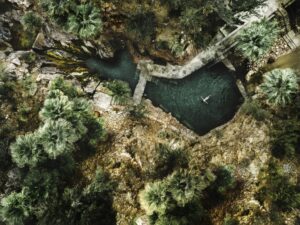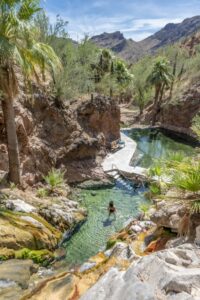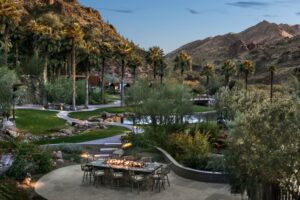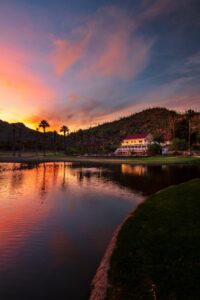Hot Springs, Cool Harvest

The Renaissance of Arizona’s Historic Wellness Resort
Writers Shoshana Leon and Rebecca L. Rhoades // Photography Courtesy of Castle Hot Springs
Rising from the rugged Bradshaw Mountains just an hour north of Phoenix, Castle Hot Springs stands as a testament to Arizona’s rich history and its modern renaissance as a luxury wellness destination. The resort, which draws its name from the natural hot springs that produce more than 200,000 gallons of pure, odorless 120-degree mineral water daily, has evolved from a historic retreat for America’s elite to a contemporary culinary oasis that celebrates the bounty of the desert.
A Storied Past Reborn



Castle Hot Springs’ fascinating history is steeped in both fact and folklore. While local lore suggests U.S. Army Col. Charles Craig discovered the springs in 1867, historical records indicate Euro-American settlers and prospectors found the area in the late 19th century, with Indigenous Yavapai and Apache people having utilized these healing waters for centuries prior. Nearly three decades later, Frank Morrill Murphy, a self-made millionaire from Wisconsin, recognized the potential of these therapeutic waters and opened Castle Hot Springs as a luxury healing retreat in 1896.
The resort quickly became the winter playground for some of America’s wealthiest and most influential families. The guest registry included the Rockefellers, Vanderbilts, Wrigleys, Roosevelts, Cabots and Carnegies. Several U.S. presidents, including Woodrow Wilson, Calvin Coolidge and Herbert Hoover, sought respite at the desert hideaway. In 1945, a young John F. Kennedy spent several months at Castle Hot Springs recovering from injuries sustained during World War II.
After Frank Murphy’s death in 1917, Castle Hot Springs changed hands several times before being purchased by the Talley family, who also owned the Arizona Biltmore. Tragedy struck in 1976 when a spark from a fireplace ignited a fire that destroyed the main hotel building. The property subsequently served as an Arizona State University conference center until 1987, then exchanged ownership multiple times before a partnership of local investors purchased it in 2014.
“The ownership and management group consists of Arizona natives who did this for the legacy and history of Castle Hot Springs and Arizona,” says Steve Sampson, who was involved with the resort’s revival. “The vision was for Castle Hot Springs to be reborn as a luxury wellness and adventure retreat, and to once again become a premier resort destination.”
After a meticulous five-year restoration, Castle Hot Springs reopened in 2019 to worldwide acclaim and has since established itself as one of the nation’s most luxurious hot springs resorts. In 2025, it celebrates more than six years of providing guests with an unparalleled retreat experience that honors its historical roots while embracing modern luxury.
Desert Luxury Reimagined



Today’s Castle Hot Springs features 34 luxury cabins and bungalows, some with piping directly from the hot springs into oversized soaking tubs with open ceilings, allowing guests to enjoy the therapeutic waters under a canopy of stars. Five original buildings have been carefully restored, preserving the property’s historical character while incorporating contemporary amenities.
“The mood, music and aura of the property connect directly to the early 20th century,” Sampson explains. “It’s truly a step back in time.”
This blend of historical authenticity and modern luxury has made Castle Hot Springs a destination for both adventure and wellness seekers.
“We see many Arizonans as frequent guests, as well as affluent travelers from across the country who appreciate the rich history and unique experience we offer,” Sampson says.
Guests can choose from a variety of activities to recharge, including soaking in the hot springs, hiking the surrounding mountains, relaxing by the pool or enjoying a therapeutic massage in the expanded spa cabana. Modern additions include a via ferrata adventure course, dual pickleball courts, plein air painting classes, and a dedicated history room with curated exhibits. The property also maintains horses and stables, honoring its legacy as a Western destination.
A Farm-to-Table Revolution



While the thermal pools may have initially drawn visitors to Castle Hot Springs, the resort’s culinary program has emerged as an equally compelling attraction — one that has evolved significantly since the property’s reopening.
What began as a modest fan-shaped culinary garden supplying herbs, microgreens and edible flowers has blossomed into a comprehensive agricultural program spanning 5 acres. This expansion includes a 1-acre main garden with high-tunnel greenhouses, a specialized tomato greenhouse, a 3-acre agave farm for house-made spirits, a quarter-acre of stone fruit trees and a flourishing citrus orchard.
Following agronomist Ian Beger around the expansive gardens at Castle Hot Springs is like spending time with Mother Nature’s version of Willy Wonka. Knowledgeable and passionate about every plant under his care, he eagerly shares gardening wisdom and random tidbits about each variety.
“Our main goal is to provide the best quality fruits, vegetables and herbs to the kitchen, bar and, ultimately, the guests,” Beger says. “We’re focused on flavor more than anything.”
As he strides through rows of verdant greenery, Beger is constantly plucking, picking and trimming with an acute awareness of every leaf, stalk and petal. He reaches down and removes a fleshy, ruffled leaf studded with shimmering crystals that look like hoarfrost — glacier lettuce, an edible succulent that’s crisp with a slight seawater bite.
“This plant really does a good job of expressing what the spring water does to the produce,” Beger explains. “What you’re tasting is almost like mineral water concentrates. It’s almost like tasting the ocean.”
The farm now supplies more than 80% of the restaurant’s vegetables — an impressive feat considering Harvest, the resort’s restaurant, serves three meals daily to approximately 60 guests. More than 500 varieties of produce are grown on-site, with the farm team experimenting with about 30% new crops each year.
“We have very unique growing conditions,” Beger says. “We use spring water for everything, and we’re in a valley. It’s unlike anywhere else that I’ve ever grown before.”
To determine which plants thrive in these distinctive conditions, the farm team has trialed more than 1,000 varieties of produce since the resort’s reopening. Produce that isn’t consumed immediately is pickled, cured or fermented, preserving flavors for out-of-season use. Herbs and flowers are dried for teas and simple syrups.
In recent years, the resort has added 100 laying hens, allowing Harvest to serve farm-fresh eggs alongside the bounty of fruits and vegetables. Daily farm tours and immersive culinary workshops have become highlights for guests eager to deepen their understanding of sustainable agriculture.
Culinary Innovation in the Desert



The evolution of Castle Hot Springs’ culinary program parallels the growth of its agricultural endeavors. When the resort reopened, Chef Christopher Brugman launched Harvest Restaurant, establishing a farm-influenced approach to dining. In late 2020, sous chef John Amman took over as executive chef, deepening the connection between farm and table.
“Our concept has changed a lot since our first season,” Amman explains. “We had this farm in our backyard, and it wasn’t as much of a highlight as it is now. There was a natural evolution of utilizing the produce we grow and minimizing waste, which is something we really focus on here.”
For Amman, the farm’s diversity presents both challenges and opportunities for creativity in the kitchen.
“Ian’s lucky because he has one customer,” Amman says with a smile. “I’m buying it all. The challenge for the back of the house is how we are going to use all of the stuff from the farm. It has really helped me find my culinary style.”
One guest-favorite dish is the Mokum carrot bisque, featuring small, exceptionally sweet carrots grown on the property.
“It’s the best carrot you’ll ever have,” Amman says. “The carrots are as sweet as candy, and that makes a substantial impression on the dish. People come back just for the Mokum carrot soup.”
Amman also points to the intermezzo, or amuse-bouche, as a highlight of the dining experience. This chef-curated surprise bite isn’t listed on the menu but provides an opportunity for the culinary team to showcase the day’s harvest in creative ways.
“It’s a small bite, but it’s straight from the farm,” Amman notes.
Throughout the resort, the bounty of the farm appears in unexpected places. Bartenders use fresh-pressed sugarcane juice to sweeten house-made lemonade as part of an innovative molecular mixology and farm-to-bar program. The refreshing hibiscus tea — a fuchsia-hued welcome drink offered upon arrival — features hibiscus flowers and blue spice basil grown on site. Fresh-picked tomatoes, celery, onions, garlic and herbs serve as the base for the resort’s signature Bloody Mary mix.
The Castle Hot Springs Brewery, housed in the renovated historic laundry building, produces a house lager made with mineral water from the hot springs. New amenities include agave spirit tastings featuring products from the resort’s 3-acre agave farm and the popular Sonoran Epicurean Escape culinary retreats.
A Harmonious Blend of Past and Present



Castle Hot Springs has successfully bridged its storied past with contemporary luxury, creating an experience that resonates with today’s discerning travelers while honoring the property’s historical significance. The integration of wellness, adventure and exceptional farm-to-table dining has positioned the resort among the nation’s premier destinations.
“I do see our dining as being a huge driving force with our guests,” Beger observes. “We’re really trying to be creative with it and take it to new levels.”
While guests initially may be drawn to Castle Hot Springs for its healing waters and historical significance, they return for the complete experience — one that nourishes body and soul through thoughtful hospitality, natural beauty and culinary excellence that can only be described as a true taste of Arizona.

